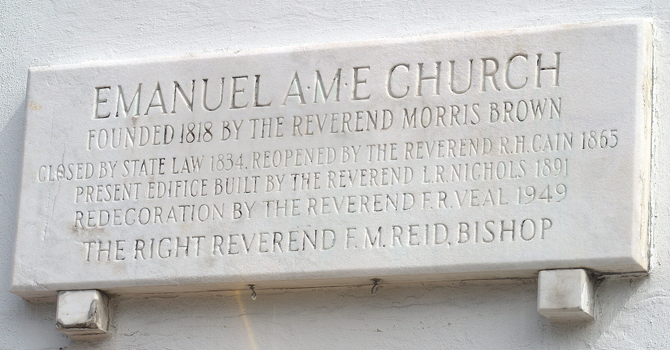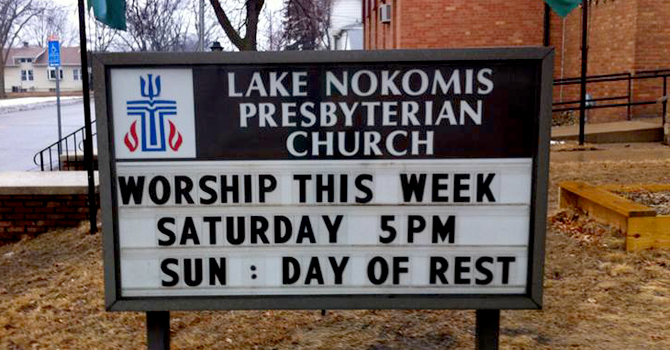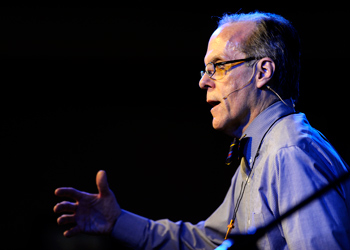Editor’s note: Faith & Leadership offers sermons that shed light on issues of Christian leadership. This sermon was preached at Metropolitan AME Church in Washington, D.C., June 21, 2015, the Sunday after nine people were shot and killed at Emanuel AME Church in Charleston, South Carolina.
In times like these, communities in crisis look everywhere for answers and relief. Non-believers, tired of the trite “God will make a way…” concessions amid their suffocations, require more, while people of faith look to God and the church for that soothing balm in Gilead.
The preached word, no matter the circumstance, should always be a sacred moment of encounter with the divine. This moment is no different.
In seminary, they teach us the formula that supposedly helps usher in that spirit. For each text in the common lectionary, there are four perspectives that should inform its interpretation -- the theological, the pastoral, the exegetical and the homiletical. In our best moments, we are to blend these seamlessly.
The exegetical perspective calls us to read the text closely. Immediately preceding today’s passage from Mark’s Gospel is the parable of the sower, in which Jesus claims in verses 10 to 12 that understanding the Kingdom of God is limited to those on the inside. Yet, a few short verses later, he finds himself having to explain the parable to the disciples, his “insiders.”
The text points us to two things of special note:
First, in verse 40, Jesus asks the disciples, “Why are you afraid? Have you still no faith?” In other words, he asks them, Do you not believe that sowing good seeds on fertile ground will yield sufficient fruit; or will your faith crumple when trouble comes?
Second, after Jesus calms the winds and reveals that their faith must be deepened, the disciples -- who have been with Jesus all along -- realize that they still don’t know exactly who he is.
“Who then is this, that even the wind and the sea obey him?” they ask. The crucial question is whether they will respond to their uncertainty about his identity with a curious faith or with fear.
From the homiletical perspective, this text -- and more especially in the aftermath of Charleston -- is most preachers’ dream.
“We’ll Understand It Better By and By,” followed by a rousing interpretation of the passion of the Christ, is sure to get a shout, providing congregations with the energy for purging our collective grief.
But careful probing pushes us to understand the text fully in its context. When the windstorm happens, the boat is en route to Gentile territory. Their journey is atypical; some might even say inappropriate. Surely the disciples see the storm as a foreshadowing of the consequences of reaching out to strangers and enemies. But Jesus is determined to transcend hate and fear.
The pastoral perspective, in many ways, is the most difficult one. How can a spiritual leader best help calm a real and present fear?
As one interpreter of this text has written, “The visceral response of Jesus’ terrified disciples in a frail storm-tossed boat resonates both in the individual lives of Christians and in their corporate life in congregations and civic communities. We are afraid of the ‘wind and waves’ that assail our fragile vessels -- our lives, our churches, our cities, and nations.”
How can we help each other beat back the fatigue that attends constant assault and near-debilitating anxiety? There is a fine line to be navigated here.
Jesus does not suggest that the disciples should not be afraid; rather, he asks why they are afraid in light of their faith. Teasing out this distinction is the difficult work that we must do as spiritual leaders and as communities of faith.
That teasing out is possible only if we take seriously the challenge of the theological perspective, which generates more questions than clear answers.
Who is Mark suggesting Jesus is? What is the nature of his kingship? What is the source of its authority? Who is this man who commands God’s creation and brings order to chaos? The telling moment in the text that makes us all uncomfortable is [when] the disciples respond to a theological revelation about who God is with fear and not with faith.
Consider now with me the possibility that the uninterrupted assault on black humanity -- from the moment of enslavement in this country to the heinous act of violence at Mother Emanuel this week -- has everything to do with our unwillingness to unpack this conundrum, that faith and fear have always been inextricably intertwined in the Christian imaginary, nowhere more so than in this land we find ourselves in today. And our continued failure to reckon with it can only lead to continued violence.
Let us go to the other side.
The black body is the geography upon which the myth of white supremacy fought its primary battle and will fight its ultimate one. The letting of black blood funds the expiation of America’s sins. As difficult as it is to hear and as painful as it may be to believe, violence against black bodies is the essence of American history, prosperity and hegemonic control of land, and thus wealth.
Those of us who understand signifying as a black cultural practice saw even President Obama make this point, using indirection as a rhetorical strategy in his remarks about the shooting at Mother Emanuel.
He said:
"At some point, we as a country will have to reckon with the fact that this type of mass violence does not happen in other advanced countries…. I say that recognizing the politics in this town…. But it would be wrong for us not to acknowledge it. And at some point it’s going to be important for the American people to come to grips with it, and for us to be able to shift how we think about the issue of gun violence collectively. The fact that this took place in a black church obviously also raises questions about a dark part of our history."
President Obama daringly, almost boldly, presents gun violence and assaults against black bodies in lockstep as evidence of a fundamental failure in the American ideal of freedom and democracy.
That failure can only be corrected if we do the hard work of supplanting America’s myth of redemptive violence. As our brothers and sisters in South Africa knew [when] trying to transcend its racist history of apartheid, truth must precede reconciliation. One sad but honest truth is that Christians -- fear- and not faith-driven, skeptical like the disciples -- do as much to support the myth as we do to undermine it.
The myth of redemptive violence is theologically grounded in a view of Christian atonement theory that posits that Jesus’ horrid torture, suffering and death are necessary for the forgiveness of sins. This Christian logic plays itself out daily as black bodies are made to suffer as a means of cleansing America from its original sins of colonial conquest of the natives’ land and enslavement of Africans to work it.
But instead of redemption, violence against black people draws America more deeply into amnesia surrounding its past and denial of its present. It is an all-too-familiar story that cannot be resolved unless we are willing to go to the other side, and on that side we see an ugly truth.
Deforming and dealing death to black bodies is America’s obsession and its desperate plea for redemption and salvation. Blacks are forced to die in the stead of whites, becoming criminal and Christ, and Christ as criminal; both the moral compass and the sacrificial lamb. We often accept our role as both, even to the point of future peril.
While South Carolina’s Gov. Nikki Haley calls for the death penalty, the forgiveness and healing narrative of the victims’ families in Charleston has already begun to take shape and is a beautiful but painful case in point. The killer is unrepentant, while Felicia Sanders, a survivor of his redemptive violence, who saw Dylann Roof kill her son and who threw her body on her granddaughter to hide her, publicly petitions God to have mercy on his soul.
Forgiveness and healing are important narratives, but they cannot dominate our imaginary until the seas troubled by racist hatred have been calmed by truth, until the fear that underwrites the violence is replaced by faith in the oneness of all humanity with the divine in all of its manifestations.
What these last two hyper-violent years makes clear is America cannot atone for its sin by attacking and killing black bodies. Another strategy must be adopted if we are to survive.
We must go to the other side.
Brit Bennet’s article “White Terrorism Is As Old as America” in yesterday’s New York Timeshelps us get there. A “white terrorist is an enigma,” she writes. “A white terrorist has no history, no context, no origin. He is forever unknowable. His very existence is unspeakable. We see him, but we pretend we cannot. He is a ghost floating in the night.”
Social media is similarly instructive. A series of Twitter posts read: “With any other kind of ‘terror’ we would be trying to infiltrate the spaces where it fostered and destroy the networks that produce it. And this is why many of us are angry with our society’s inability to even call it what it is -- terror rooted in ideologies of white supremacy. Because if we are to even name it, what chance do we have of even beginning to confront it?”
Redemptive violence articulates itself foremost in three closely tied ways: symbols, culture and rhetoric. The most obvious example in this moment is the symbol of the flag -- the flags of colonialist Rhodesia and apartheid South Africa that adorned Roof’s clothing in one of the first pictures of him that appeared, and the white supremacist Confederate flag that flies next to the Confederate war memorial on the South Carolina State House grounds.
Its meaning is undeniable. The designer of the second Confederate flag, arguing that the flag’s background should be white, wrote, “As a people, we are fighting to maintain a Heaven-ordained supremacy of the white man over the inferior or colored race; a white flag would thus be emblematical of our cause. Upon a red field would stand forth our Southern Cross, gemmed with the stars of our confederation, all combined, preserving in beautiful contrast the red, white, and blue.”
White supremacists’ claim that the flag is about heritage is true -- the heritage of enslavement and of the letting of black blood in war to preserve it. Civil War re-enactments are about redemption. The paradox is absurd; we must help them find their way out of the trap they have set for themselves.
Culture, too, bears the burden of reinforcing this myth. “The Birth of a Nation” is too obvious a choice. The more problematic example involves a genre many old souls hold dear: the cowboy story. What makes for a good Western is a formula that goes something like this: a lone wolf or a small posse of good guys kills anyone they determine is a bad guy. There is no consequence to this violence, because it’s often state-sanctioned, since the good guy and his posse are the sheriff and his marshals. We are never burdened with the context out of which the person upon whom violence is inflicted emerges.
Safe from the harm of outsiders, Dodge remains tranquil. What this narrates to us, and what we accept, is that one person or group is the ordained arbiter of good and evil, and that person can use violence to maintain hegemonic control.
But no one stops to consider how that violence does not stop reverberating. It’s never a single, isolated act; unbothered, we await the next episode of a formative national narrative that uses violence to preserve itself from itself.
Redemptive violence is nowhere more dangerous than when its symbolic and cultural forces are supported with rhetoric. Roof allegedly said at one point, “You rape our women, and you are taking over our country. And you have to go.”
He was following the line of rhetoric that was so popular during the 2012 election, when virtually every Republican candidate implored voters to help them “take back our country” -- “from a black president,” is what the dog was whispering.
Rhetoric as a tool of redemptive violence also has the potential for a dualism that can rob us of our critical responsibility. If they tell you that you and your people are violent, and they must protect you from yourself, you begin to believe it. And you begin to believe that if you don’t resist arrest you won’t get a rough ride from people you pay to “protect and serve.”
The converse of the myth of redemptive violence, it seems to me, is the recovery of history and then a meaningful engagement with it. Only then can we craft a new narrative, one based in truth.
The African Methodist Episcopal Church exists because our forefathers were determined to craft a new narrative. How ironic is it that the same act that has come to symbolize African Methodism’s founding -- a rejection of black bodies for prayer -- is the very one that has thrust us back into the nation’s spotlight?
Perhaps it isn’t irony at all but, rather, a much-needed reminder that Richard Allen and his colleagues’ determination to reconstruct Christianity suggests that we can generate a new narrative.
They were willing to go to the other side. They embraced what Dennis Dickerson, a historian at Vanderbilt University, has called a ministry of risk. When whites learned of Denmark Vesey’s planned slave insurrection, in which Morris Brown, pastor of Mother Emanuel, was implicated, Vesey was executed, and Brown was forced to flee. Richard Allen gave Morris Brown refuge because both men understood that freedom was possible only if they were willing to embrace a ministry of risk, a ministry on the edge.
Clementa Pinckney came as close as anyone to embracing this ministry, and the attack on his life was an attack on that church’s history and his commitment to embracing it. One of the ways we can honor his memory and avenge the deaths of the fallen is to reject the myth of redemptive violence and recover our history.
In so doing, we provide for the world a model for a more humane theology, one that embraces the African theological imagination and its quest for freedom and justice.
Painfully, we are cut off from that imagination in the most meaningful ways, but we do have the memory of those who were closest to it and the legacy of their written and spoken words to guide us. If we embrace a ministry of risk, we will accept the challenge of mining every story in African cosmology that reveals something to us about the marriage of the anthropological and the theological, about man’s relation to God. These stories, inevitably, will point us toward freedom and not violence.
Our only victory in this moment is the stark realization that the fight is perpetual, that we will need a revolutionary patience to endure.
Amid the crashing waves, let us go to the other side.
Amid the howling wind, let us go to the other side.
Amid the blood-soaked carpet of Mother Emanuel African Methodist Episcopal Church, let us go to the other side.
Amid the eternal human struggle between faith and fear, let us go to the other side.
For Clementa Pinckney, we must go to the other side.
For Cynthia Hurd, we go to the other side.
For Sharonda Singleton, we go to the other side.
For Myra Thompson, we go to the other side.
For Tywanza Sanders, we go to the other side.
For DePayne Middleton Doctor, we go to the other side.
For Susie Jackson, we go to the other side.
For Ethel Lance, we go to the other side.
For Rev. Daniel Simmons, we go to the other side.
For ancestors known and known...
For descendants still unborn...
Let us go.









